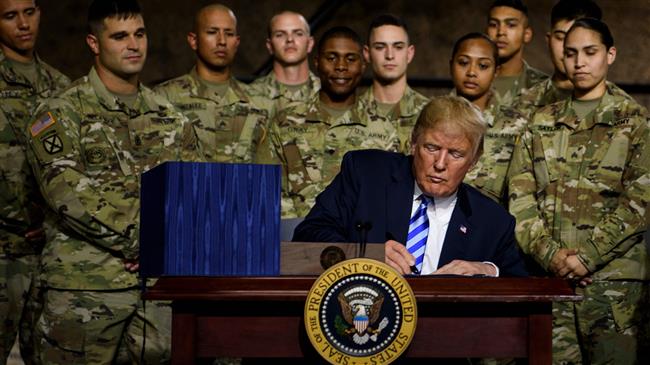Trump approved the massive budget on Monday during a signing ceremony at Fort Drum, a US Army base which is home to the Army’s 10th Mountain Division and has deployed the most troops to US wars abroad since the 9/11 attacks.
“We believe our war fighters deserve the tools, the equipment, and resources they have earned with their blood, sweat, and tears,” Trump said. “This authorization will give America’s war fighters the firepower they need to win any conflict quickly and decisively.”
The new act allows the Pentagon to spend $639.1 billion in base funding, while earmarking another $69 billion to fund wars overseas and some $8.9 billion for obligatory military expenditures.
Trump said the budget was aimed at revitalizing the US military, one of his key campaign promises.
“Hopefully, we’ll never have to use it, but if we do, no one stands a chance,” Trump said of the US military prowess.
Under the new law, troops will get 2.6 percent pay rise, their first pay raise in around a decade.
More importantly, the act identifies emerging technologies such as artificial intelligence, space and counter-space capabilities, cyber attacks, foreign influence operations, and hypersonic weapons as threats.
It also singles out Russia, North Korea, China and Iran as adversaries that need to be countered.
Countering Russian aggression
The US has long accused Russia of seeking to intervene in its democratic process, a claim that received much more attention following Trump’s surprising victory over his Democratic rival Hillary Clinton in the 2016 race for the White House.
Then-US President Barack Obama and all 16 US intelligence agencies alleged that Moscow had orchestrated a massive online campaign, including hack attacks against the Democratic Party, to turn the page in Trump’s favor.
The act specifically states that part of the massive military funding will go to “cyber warfare and influence operations to counter Russian aggression, cyber, and information warfare threats.”
Stepping up pressure on China
The new budget will also fund Trump’s Space Force, the sixth branch of the US military which will specifically focus on militarizing the space.
Trump said an space force was necessary to confront what he called US “adversaries” in space, specifically naming China
“In order to maintain America’s military supremacy, we must always be on the cutting edge,” the president said. “That is why we are also proudly reasserting America’s legacy of leadership in space. Our foreign competitors and adversaries have already begun weaponizing space.”
“We’ll be catching them very shortly,” he added. “They want to jam transmissions, which threaten our battlefield operations and so many other things. We will be so far ahead of them in a very short period of time, your head will spin.”
US Vice President Mike Pence announced Thursday that the Space Force will come to life over the next few years.
Under the new act, products by Chinese tech giants Huawei and ZTE will largely be banned from use by the US government and government contractors.
The policies against Russia and China fall in line with Trump’s new national security strategy, which was released earlier this year.
Afghanistan, Iraq
The Pentagon is allowed under the new budget to spend $5.2 billion to prolong operations in Afghanistan, 16 years after the US soldiers invaded the country on terrorism charges.
The US military will also receive $820 million to continue operations in Iraq.
New weapons purchases
The new act also authorizes $7.6 billion to purchase 77 F-35 Joint Strike Fighters, $24.1 billion to fund the construction of 13 new ships and $452.6 million for six additional AH-64E Apache attack helicopters.
The US Navy will also be allowed to purchase 24 F/A-18 Super Hornet fighter jets and 10 P-8A Poseidon naval surveillance aircraft and 25 AH-1Z Cobra helicopters.
Additionally, the number of soldiers on active duty will be increased by 15,600 next year.
“The act sets active duty end strength for the Army at 487,500 in fiscal 2019, which begins Oct. 1, 2018. The Navy’s end strength is set at 335,400, the Marine Corps’ at 186,100 and the Air Force’s at 329,100,” according to Pentagon.
The next year’s budget also bars the delivery of F-35 jets to NATO ally Turkey amid concerns over Ankara’s purchase of Russian missile defense systems.
